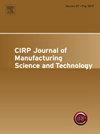Progressive scheme via eccentric rotation of abrasive cutting edges for minimum damage machining of fibre reinforced polymer composites: Micro-mechanics and performance aspects
IF 4.6
2区 工程技术
Q2 ENGINEERING, MANUFACTURING
CIRP Journal of Manufacturing Science and Technology
Pub Date : 2025-02-01
DOI:10.1016/j.cirpj.2024.12.002
引用次数: 0
Abstract
Progressive-intermittent cutting using controlled eccentricity to the rotation of grinding wheel, referred to as “eccentric sleeve grinding”, is projected as one of the promising methodologies for minimising damages while machining Fibre Reinforced Polymer Composites (FRPs). This paper unveils the micromechanics of eccentric sleeve grinding through a detailed investigation of the progressive interaction of abrasive cutting edges with a fibre-matrix system. The theoretical model in this paper provides a comprehensive understanding of the contact/cutting behaviour of abrasive grains located on a wheel that rotates with fine eccentricity during its interaction with the matrix as well as fibres embedded in the matrix. A seven-grit experimental analogy of progressive cutting with the assessment of elastic and brittle modes of material removal, supplemented with the analysis of grinding force and surface micrographs, is a unique contribution to the work. Defect volume estimation using X-ray tomography, residual stress measurement using Raman Spectroscopy, and the hypothesis of skin level defects have also been discussed to provide a deeper insight into the micro mechanism of eccentric sleeve grinding.
在加工纤维增强聚合物复合材料(FRP)时,利用砂轮旋转的可控偏心进行渐进-间歇切削(简称为 "偏心套筒磨削")被认为是将损伤降至最低的有效方法之一。本文通过详细研究磨料切削刃与纤维基质系统的渐进式相互作用,揭示了偏心套筒磨削的微观力学。本文的理论模型提供了对位于砂轮上的磨粒接触/切割行为的全面理解,砂轮在与基体以及嵌入基体中的纤维相互作用的过程中以微小的偏心率旋转。通过对材料去除的弹性和脆性模式进行评估,并辅以对磨削力和表面显微照片的分析,对渐进切削的七磨实验进行了类比,这是对这项工作的独特贡献。此外,还讨论了利用 X 射线断层扫描估算缺陷体积、利用拉曼光谱测量残余应力以及皮层缺陷假设等问题,以便更深入地了解偏心套筒磨削的微观机制。
本文章由计算机程序翻译,如有差异,请以英文原文为准。
求助全文
约1分钟内获得全文
求助全文
来源期刊

CIRP Journal of Manufacturing Science and Technology
Engineering-Industrial and Manufacturing Engineering
CiteScore
9.10
自引率
6.20%
发文量
166
审稿时长
63 days
期刊介绍:
The CIRP Journal of Manufacturing Science and Technology (CIRP-JMST) publishes fundamental papers on manufacturing processes, production equipment and automation, product design, manufacturing systems and production organisations up to the level of the production networks, including all the related technical, human and economic factors. Preference is given to contributions describing research results whose feasibility has been demonstrated either in a laboratory or in the industrial praxis. Case studies and review papers on specific issues in manufacturing science and technology are equally encouraged.
 求助内容:
求助内容: 应助结果提醒方式:
应助结果提醒方式:


